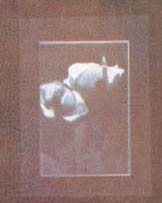
When three saturated primary pigments are printed on top of each other in tricolor gum printing, they create a neutral black or dark grey. (See the darkest values on the right side of the bowl in the apricot picture on my home page, for example.
The idea that three primary colors can't add to black seems to have drifted over from commercial printing, where "due to impurities present in all printing inks a mix of these colors yields a muddy brown." But this limitation of commercial printing inks does not apply to the pure pigments we use for gum printing.
Painters would be very surprised to hear this idea that it takes more than three colors to make black, as they are used to making black from just two colors all the time, and in fact many if not most painters prefer to produce black by combining two complementary colors rather than using black paint. Handprint.com has a list of pairs of complementary watercolor pigments that combine to produce black:
http://handprint.com/HP/WCL/mixtable.html
It's even easier to produce black by mixing or overlaying three colors: any combination of three colors whose "mixing triangle" (see handprint's pages on color mixing) includes the center of the color wheel will produce black if used in the right proportion to each other; in other words, any combination of three colors that are somewhere in the ballpark of being equidistant on the color wheel should produce black when combined.
An easy way to check the balance of any combination of pigments that you're trying is to print a small negative (or a step tablet for that matter) three times, once for each pigment mix. If you've got a good combination of pigments, in balanced proportion to each other, the result should be a print that ranges from neutral grey to neutral black. If there's a color cast to the final print, you need to adjust the proportions of the pigments.
When the above condition isn't met; when the mixing triangle does not encompass the center of the color wheel, it is possible to achieve a muddy brown color similar to that obtained when mixing commercial process inks. Below is an example of one such unfortunate combination; the three colors together produce a bilious purplish brown:

This is a combination of PY110, ultramarine, and an especially wimpy and pinkish version of PV19 (M. Graham's "quinacridone rose"). If a mixing triangle is drawn on the CieLab color wheel with one of these pigments at each corner of the triangle, the area of the triangle does not include the center of the wheel (black); in other words, theoretically at least, these three pigments when mixed cannot produce black, and this practical demonstration seems to indicate that in this case, the theory is correct. This particular version of PV19 would do better with pthalo (PB15:3) and PY 97 as companion colors.
If you look at tricolor gum prints on the web, you will come across a number of examples of this brownish look from a poor choice of pigments in combination with each other. Some gum printers attempting tricolor gum and encountering this kind of effect on their first tries have given up on tricolor gum and gone to a gumover or four-color process instead. But to assume that the brown color is typical of tricolor in general, rather than a result of a poor choice of pigments, is a disservice to tricolor gum.
Copyright Katharine Thayer, all rights reserved